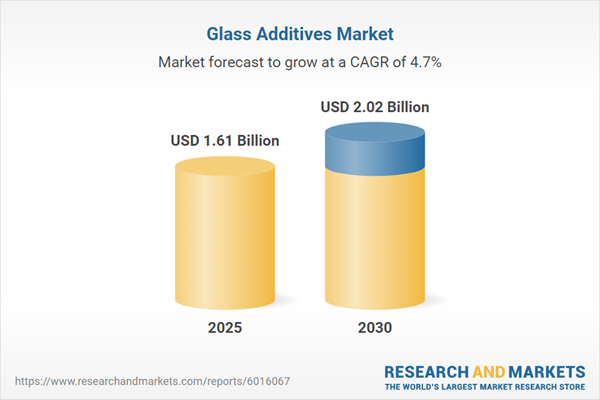Speak directly to the analyst to clarify any post sales queries you may have.
The glass additives market is shifting rapidly as new technologies, stricter regulations, and changing procurement dynamics reshape business priorities and supplier relationships. Senior executives now require agile strategies and robust partnerships to sustain growth and address evolving demands.
Market Snapshot: Size and Growth Trajectory in the Glass Additives Market
The global glass additives market is advancing, with current momentum fueled by the increasing preference for sustainable glass products and the adoption of cutting-edge manufacturing processes. The market size is projected to progress from USD 1.53 billion in 2024 to USD 1.61 billion in 2025, reaching an estimated USD 2.23 billion by 2032. This reflects a steady compound annual growth rate (CAGR) of 4.78%. Growth is underpinned by the search for enhanced performance features, improved efficiency, and the need to comply with changing regulations. Leading companies are reengineering supply chains and compliance models to support clients as they adapt to evolving industry and technical benchmarks.
Scope & Segmentation of the Glass Additives Market
This section presents senior leaders with strategic clarity regarding segmentation, technology adoption, and geographic dynamics—all essential for effective planning and mitigation of operational risks in the glass additives industry. Understanding these dimensions empowers organizations to forecast market shifts with greater accuracy and develop segment-driven commercial approaches.
- Product Types: The market comprises anti-foaming agents, clarifiers, colorants, fining agents, nucleating agents, rheology modifiers, and UV absorbers. Both silicone and non-silicone options as well as sodium-based and sulfate-based fining agents support customized manufacturing and enable higher production precision across a range of glass applications.
- End Uses: Core applications span container glass, fiberglass used for insulation and reinforcements, flat glass panels, bioglass, optical glass, and photochromic glass. Each category is subject to its own procurement criteria and regulatory standards, impacting supply practices from sourcing to delivery along the value chain.
- Geographic Coverage: The market covers the Americas (with focus on the United States, Canada, Mexico, and Brazil), Europe, the Middle East and Africa (notably Germany, United Kingdom, United Arab Emirates, and South Africa), and the Asia-Pacific region (including China, India, Japan, South Korea, Australia, and Southeast Asia). Regional variations influence procurement strategies, local policy compliance, and the pace of supply network evolution, further affected by differing levels of maturity and innovation.
- Key Players: Major market participants include Evonik Industries AG, Dow Inc., Nouryon Chemical B.V., Cabot Corporation, BASF SE, Omya AG, Sibelco NV, Ferro Corporation, PPG Industries Inc., and Saint-Gobain S.A. Leading organizations successfully integrate local presence with global approaches to meet shifting technology standards and customer requirements.
Key Takeaways for Senior Decision-Makers
- Recent advancements in glass additive technologies offer manufacturers opportunities to deliver durable, application-specific products tailored for emerging industry segments.
- Greater sustainability requirements are prompting rapid formulation development compatible with traceability demands and environmentally driven compliance mandates.
- Organizations are strengthening supply chain resilience through diversified sourcing models and the strategic use of nearshoring, ensuring adaptive response capabilities in volatile markets.
- Partnerships between additives suppliers and glass manufacturers are becoming more integral, promoting collaborative development and accelerating product introduction in niche sectors.
- Maintaining competitive edge now rests on deep technical skillsets and proactive regulatory engagement, as well as cultivating regionally adapted supply solutions that anticipate customer and policy trends.
Tariff Impact: Navigating Shifting Policy Environments
Recent changes in U.S. tariff regulations have motivated glass additives companies to reevaluate and reconfigure their supply chain frameworks. Enhanced diligence in supplier verification, along with optimized inventory and a prioritization of nearshoring, have grown in importance for safeguarding cost structures and mitigating operational risk. Firms now leverage longer-term supplier contracts and intensify R&D collaboration to enhance product variety, supporting smooth manufacturing integration without compromising on regulatory compliance amid global market changes.
Methodology & Data Sources
This report is derived from executive-level interviews, comprehensive technical literature reviews, and the latest regulatory analyses. Scenario modeling is utilized to assess compliance and trade impacts, with perspectives reinforced through R&D and procurement leader commentary and corroborated by focused industry case studies.
Why This Report Matters
- Equips senior executives and technical managers to strategically align innovation and procurement practice amid the dynamic glass additives environment.
- Facilitates robust supplier engagement through clear trend analysis across technology, customer demands, and regional market specifics.
- Delivers concise, actionable insights into the evolving risk landscape related to regulatory and trade policy updates, supporting agile investment and operational decisions.
Conclusion
Sustained success in the glass additives market relies on proactive collaboration, strong compliance frameworks, and the cultivation of resilient supplier ecosystems to optimize performance and secure future growth opportunities.
Additional Product Information:
- Purchase of this report includes 1 year online access with quarterly updates.
- This report can be updated on request. Please contact our Customer Experience team using the Ask a Question widget on our website.
Table of Contents
3. Executive Summary
4. Market Overview
7. Cumulative Impact of Artificial Intelligence 2025
Companies Mentioned
The companies profiled in this Glass Additives market report include:- Evonik Industries AG
- Dow Inc.
- Nouryon Chemical B.V.
- Cabot Corporation
- BASF SE
- Omya AG
- Sibelco NV
- Ferro Corporation
- PPG Industries, Inc.
- Saint-Gobain S.A.
Table Information
| Report Attribute | Details |
|---|---|
| No. of Pages | 192 |
| Published | November 2025 |
| Forecast Period | 2025 - 2032 |
| Estimated Market Value ( USD | $ 1.61 Billion |
| Forecasted Market Value ( USD | $ 2.23 Billion |
| Compound Annual Growth Rate | 4.7% |
| Regions Covered | Global |
| No. of Companies Mentioned | 11 |









